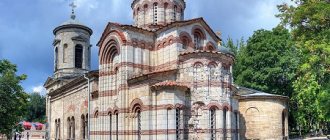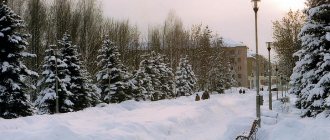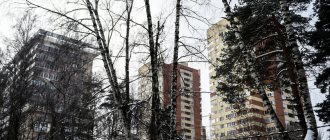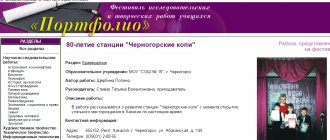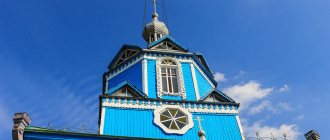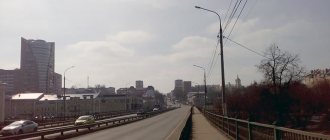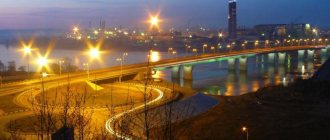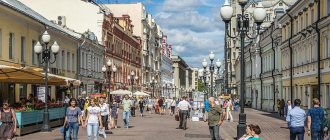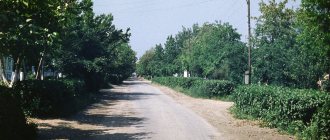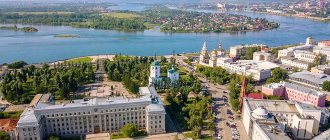The streets will tell you
| Our coat of arms (animated story) |
Great is the world, great is our country. And each of us has one house. The small homeland is the closest, most immediate. Kulunda is a land of lakes and mysterious swamps, where the lands of Western Siberia, Altai and Kazakhstan meet. It was here that a settlement arose in the future, which became the city of Kupino, where we live. In the old days our region was wild, harsh and poor. Life was not easy for ordinary people. But Siberia has long attracted people with its open spaces and endless areas for arable land and livestock breeding. Fleeing from the oppression of the landowners of Russia and the lack of land, the peasants, at their own peril and risk, set off from the central provinces of the country to the east in search of favorable living conditions.
This is how it all began
Old street of the city of Kupino.jpg
The history of Kupino goes back 123 years. It was started by walkers from the Kursk province who were looking for a good life. They took a fancy to these places and settled on the estate of a wealthy Zyatkovsky peasant. Lake Mokhovoy, on the shores of which the first huts of the settlers were built, gave our city its first name: the settlement of Mokhovoy, the village of Mokhovaya, the village of Mokhovushka. Construction of the future city began along the lake, on the site of the current Naberezhnaya Street. The first two streets were founded on the mane: Shakhterskaya and Tambovskaya. By 1917, the main streets in Kupino were: Khersonskaya (now Lenin Street), Khokhlatskaya (Sadovaya), Zabytovka (K. Marx).
We invite you to travel together through the streets and squares of our city, look into mysterious corners, and relax on benches in the city park.
The station is the face of the city
We will start our journey around the city from the station.
| Old station in the city of Kupino.jpg | Station updated.jpg | Station in the city of Kupino.JPG | Railway station on the Tatarskaya - Malinovoye Ozero line..jpg |
The station is the first thing that guests who come to us see, and it is the face of the city. Our railway station building was rebuilt in 2002. Now it is two-story, and consists of a lot of marble and mirrors.
On the platform, everyone can see a steam locomotive standing on a pedestal. He is a symbol of a bygone era. It was this locomotive that first arrived in Kupino on August 6, 1915 along the new Tatarsk - Raspberry Lake railway line, built by the Nekhoroshev joint-stock company. The first train consisted of 6 cars: two passenger and four freight. The train was greeted by residents of Kupino and surrounding villages, who specially arrived to watch the “cast iron” run. He approached the station through a special arch decorated with flowers. This “moment” was saved by the photo. In honor of this event, a prayer service was organized by priest Evgeny Krylov.
Everyone who comes to our city passes by soldiers and women frozen forever, personifying the defenders of our Motherland during the Great Patriotic War. Behind the monument there is a stele with the names of residents of the Kupinsky district who died in the war. The memorial complex “To the Heroes of the Front and Rear” was opened on November 7, 1978.
Turning past the railway club, you involuntarily stop in front of a large house. It reeks of history. Once upon a time, when Kupino was very young, this was the best and tallest building. Due to its great height, people nicknamed it “London”. At one time (since 1933) the railway school No. 105 (the first secondary school in the city) was located here. Now, after restoration, this apartment building has found a second youth and looks out onto Sovetov Street with wide-open windows.
Along the main street
We go out onto the main street of the city - st. Soviets. Its length is about seven kilometers. This is the longest and greenest street, it divides the entire city in half. We take a leisurely stroll along the sidewalk, sheltered from the scorching sun by old poplars, towards the center. The city of Kupino is a regional center, the buildings and structures of regional institutions, the monument to Lenin, are also part of it and carry their share of the aesthetic load in the appearance of the city. We also have our own “White House” - the administration building. The Russian flag flies proudly above it. And recently an electronic display with a clock and weather was installed on the plinth. In June 2007, a significant event took place - the opening of a fountain in the central recreation park. Now you can admire the splashes of water shimmering in the sun, make appointments with friends, throw coins and make a wish. Nearby, children ride on swings and carousels. Imperceptibly we find ourselves on the Embankment, stretching along the lake. Old-timers said that the lake. Mokhovoye at the beginning of the 1900s was deep - 2.5 arshins, with an area of 16 dessiatines. Everyone, young and old, swam, caught crucian carp, and in winter there was a skating rink. There was a birch forest all around, where the settlers built huts: plastic and wicker huts lined with straw. Unfortunately, neither the houses nor the lake have survived.
"Lighthouse in the steppe"
Tens of kilometers away you can see the 70-meter elevator tower and the powerful buildings standing nearby. The grain growers called this giant “a lighthouse in the steppe,” and the Kupinians drew its silhouette on the city’s emblem. There is no other elevator like this in the entire Kulunda zone. It was built in 1959.
Sometimes you walk around the city and think: nowhere else are there such streets, such trees. In other places, the sun shines differently, and you won’t see so many familiar faces.
There are many glorious deeds in the history of our city: the fight against the Kolchakites, courage and hard work during the Great Patriotic War, the development of virgin lands. The history of our city, like any history, was created by people.
Hospital town
At the beginning of the twentieth century, an enthusiastic doctor, Vladimir Nikolaevich Rossov, came to our city. On his initiative, construction of a resettlement hospital began. Three years later it was built, and so thoroughly that its building has survived to this day. On the plinth you can read the date of construction - 1911. It was an unusual hospital for those times: spacious, with large, bright windows. There was a lot of air and light in it. Residents of not only Kupinskaya, but also neighboring volosts received medical care. Now the building of the first hospital in our city is protected by the state as an architectural monument. Time does not stand still. Over the past few years, extensive construction has been carried out on the hospital campus. The surgical, therapeutic, otolaryngological departments, clinic and maternity hospital were combined into one building. And now, patients who come to the hospital for treatment do not need to go outside until they are diagnosed and treated. It is interesting and a little mysterious to wander through the labyrinths of hospital corridors.
| Rossov V.N. — first doctor Kupino.jpg | Construction of a hospital in Kupino 1914.jpg | Rossova Hospital building.jpg | Clinic.New building.jpg |
Old center
Our city also has its own Red Square, located in the Old Center. Now it is increasingly called the ring road. It was here in 1909 that headman Stefan Kupin, at a gathering of peasants, proposed renaming Mokhovoe to Kupino in order to preserve the memory of his distant native village of Kupino, Kupinskaya volost, Korochinsky district of Kursk province. It is curious that the village from which the first settlers came has survived to this day, and is now part of the Belgorod region.
The music school, which began its history in 1955, is comfortably located in the old center.
And next to it is a monument to those who died during the hard years of the civil war. Let's take a photo for memory and move on. Shops, pharmacies, hairdressers.
| Old city center of Kupino.JPG | Monument to the Heroes of the Civil War.JPG | Music school building.JPG | Church.jpg |
And finally, a majestic, bright church with golden domes rises before our eyes. It stands out grandiosely among the modern buildings surrounding it. The domes of the temple have become not just an incomparable decoration of our city, they remind us of the eternal, as if they are telling each of us: don’t fuss, do good, create beauty, beauty awakens humanity, beauty helps to live... The new temple is the fruit of the labors of Hieromonk Melchizedek, parishioners and ordinary residents .
Krylov E. - the first priest.jpg Initially, the Church of the Holy Apostle-Evangelist Luke was built according to the design of the political exile A. Bobovnitsina in 1903. The first priest was Father Evgeny Krylov, a true ascetic who did a lot for his volost. In subsequent years, the church building housed a grain warehouse, a flight school, a music school, and a house of pioneers. In 2000, after long restoration work, on the Feast of the First Savior, on the Day of the Baptism of Rus', the temple was reopened and the first religious procession took place. The small building of the parish school, built in the year the church was founded, is also classified as an architectural monument. This was the very first Kupino school. It taught up to thirty peasant children in 2nd grade. Both buildings - churches and schools - are part of the historical and cultural heritage of the city of Kupino.
Here we briefly got acquainted with our beloved, hometown of Kupino. Our city is a hard worker, tireless and ageless. The older he gets, the younger he is...
It is dear to us today, and the glory of past years, and the memory of relatives and friends who lived here and invested their labor in the prosperity of their native corner. We are waiting for everyone to visit.
Chronology of the city's development
Crossword
In honor of these famous people, the streets of the city of Kupino were named. We invite you to test yourself and solve the crossword puzzle.
The streets of our city are named after them
Horizontally:
1. The great mystifier and writer of the 19th century, a classic of Russian literature - knitted, cut dresses for his sisters, wove belts, sewed scarves for himself, and was very afraid of thunderstorms
2. Hero of the Soviet Union, a native of our area, died on October 17, 1943 on the day he was awarded the high rank
3. Member of the Kupinsky volost Council of Workers' and Soldiers' Deputies, shot by Kolchak's men???
4. One of the “mothers” of International Women’s Day on March 8
5. Hero of the Soviet Union, namesake of the author of “The Little Humpbacked Horse”
6. Hero of the Soviet Union, guard major, before the war he worked as an inspector of the Kupinsky district, director of a rural school
7. In a figurative sense - the main, main direction of something; can be road, thermal, etc.
8. Introduced the famous poetic “ladder” into use, which allowed fellow poets to accuse him of cheating, since at that time they paid for the number of lines, and he received 2-3 times more for poems of similar length
9. So that the first chairman of the volost Council of Workers' and Soldiers' Deputies, who was shot by Kolchak's men, is not forgotten, 2 streets are named after him
10. Poet of the 19th century, masterfully mastered the “language of Aesop”
11. Hero of Soviet Aviation. He didn’t care where to fly, be it to America or under a bridge.
12. In Latin - “raising”, in ours - granary
13. Day of celebration of workers of this profession on August 12
14. In Ethiopia, a monument was erected to him with the inscription “To Our Poet”
15. The first to accomplish this feat was Sergeant Vyacheslav Vasilkovsky on December 6, 1941, he did it on February 23, 1943, but everyone knows him. In total, 403 soldiers performed this feat during the Great Patriotic War.
16. Perpetuated the name indicated in paragraph 6 vertically
17. In the 30s of the last century, it was believed that it was a “voluntary matter”
18. Author of the series of articles “Untimely thoughts. Notes on the revolution and culture of 1917-1918."
19. “All-Union Headman”
20. He fought against serfdom, but at the same time owned hundreds of souls, loved luxury and drink. So his famous poem is about him
21. It can be social, military, warehouse, stronghold, for recreation
22. How he fought is described by G. Paderin in a book about the Battle of Stalingrad
Vertically:
1. N.S. Khrushev promised that the Soviet people would live under this system in 1980
2. In the 20th century, the main young reserve of the CPSU
3. E. Ryazanov has it for two, and we have the face of the city
4. Killed on December 1, 1934 in Smolny by Nikolaev, an instructor of the historical-party commission of the Institute of History of the All-Union Communist Party of Bolsheviks.
5. Coming out of the registry office of the Khamovnichesky Council on May 2, 1922, this “mischievous reveler” shouted: “Now I am Duncan!”
6. Hero of the Civil War and jokes
7. An enterprise that operates and repairs rolling stock of railways, urban transport, fire engines
8. Both a gladiator and a football club
9. Representative of the hegemonic class
10. The area of economic activity that serves for the transformation, distribution and use of resources of all types (for us, unfortunately, only electrical ones)
11. Pishpek-Bishkek, and between them he is a Bolshevik, commander and organizer of the Red Army, military theorist
12. The place of death of this civil war hero is a locomotive firebox
13. Yesenin’s is “golden”, and ours is “green”
14. In our city, under this name there is both an official street and an unofficial “hill”
15. Initially, this was the name of the courtyard space, located between two streets and intended for passage
16. Border, sanitary post, forest guard post
17. L. Gaidai called his “operation” this way:
18. As they say in the film “White Sun of the Desert”... - “a delicate matter”
send answers to
| 'I love Kupino. I talk to myself and sing. And I’m not afraid, and I’m not afraid - I walk calmly. I am proud of my Kupin, I am happy with him. Let him not be very good - I understand. There is dirt that you can’t get through - I shake it off. But I still love my city, I want to live in it. I sing songs about him and compose poems. A.F. Khristisenko |
Kupino
(Novosibirsk region)
OKATO code:
50232501
Founded:
1886
Urban settlement since:
1936
City since:
1944 City of district subordination (Kupinsky district of the Novosibirsk region)
Center:
Kupinsky district
Telephone code (reference phone)
| 38358***** | 21-2-12 |
Deviation from Moscow time, hours:
4
Geographical latitude:
54°22′
Geographical longitude:
77°18′
Altitude above sea level, meters:
110 Sunrise and sunset times in the city of Kupino
Map
| Kupino: cards |
Kupino: photo from space (Google Maps) Kupino: photo from space (Microsoft Virtual Earth)
| Kupino. Nearest cities. Distances in km. on the map (in brackets along roads) + direction. Using the hyperlink in the distance , you can get the route (information courtesy of the AutoTransInfo website) | |||
| 1 | Bagan | 38 (38) | SE |
| 2 | Chistoozernoe | 59 (71) | NW |
| 3 | Karasuk | 85 (95) | SE |
| 4 | Zdvinsk | 95 (103) | IN |
| 5 | Vats | 109 (145) | WITH |
| 6 | Tatarsk | 127 (151) | NW |
| 7 | Barabinsk | 128 (303) | NE |
| 8 | Krasnozerskoe | 132 (171) | IN |
| 9 | Burla (Altai region) | 133 (148) | SE |
| 10 | Kuibyshev | 136 (313) | NE |
| 11 | Vengerovo | 150 (197) | WITH |
| 12 | Okoneshnikovo (Omsk region) | 151 (289) | Z |
| 13 | Satisfied | 154 (389) | IN |
| 14 | Cherlak (Omsk region) | 163 (371) | Z |
a brief description of
Located on the Kulunda Plain, south of Lake Chany, 581 km west of Novosibirsk.
Railway station.
48 km southeast of Kupino is the salt lake Novoklyuchevskoye, the water and muddy sediments of which have healing properties.
Territory (sq. km): 30
Information about the city of Kupino on the Russian Wikipedia site
Historical sketch
Founded in 1886 as the village of Kupino, the name comes from the surname Kupin; the personal name Kupa appears repeatedly in documents of the 16th and 17th centuries.
City since 1944
Economy
Enterprises for processing agricultural raw materials: dairy and meat processing plants, fish factories, etc. Mechanical and brick factories.
Grain, fodder and oilseed crops are grown in the Kupinsky district. They raise cattle, sheep, and poultry.
Main enterprises
BUTTER CHEESE AND DAIRY INDUSTRY
OJSC "Konservshchik"
632740, Novosibirsk region, Kupinsky district, Kupino, st.
Elevatornaya, 54 Offers:
Whole milk powder, animal butter, dairy products
Culture, science, education
Museum of History and Local Lore.
| Population by year (thousands of inhabitants) | |||||||
| 1939 | 12.3 | 1996 | 20.2 | 2007 | 16.0 | 2015 | 14.0 |
| 1959 | 23.2 | 1998 | 19.9 | 2008 | 15.7 | 2016 | 13.9 |
| 1967 | 23 | 2000 | 19.6 | 2010 | 15.4 | 2017 | 13.8 |
| 1970 | 20.8 | 2001 | 19.6 | 2011 | 14.9 | 2018 | 13.8 |
| 1979 | 19.3 | 2003 | 16.9 | 2012 | 14.6 | 2019 | 13.7 |
| 1989 | 19.5 | 2005 | 16.5 | 2013 | 14.4 | 2020 | 13.8 |
| 1992 | 19.2 | 2006 | 16.3 | 2014 | 14.2 | 2021 | 13.7 |
